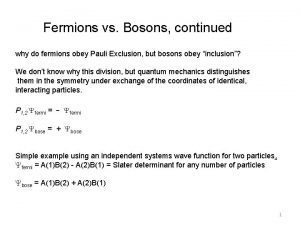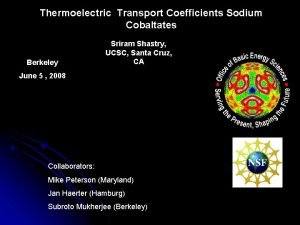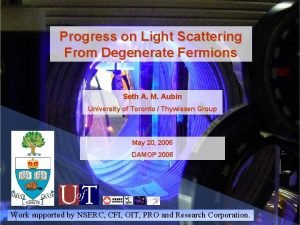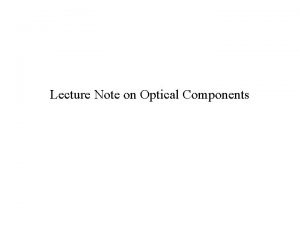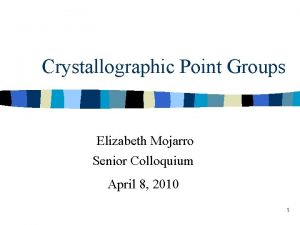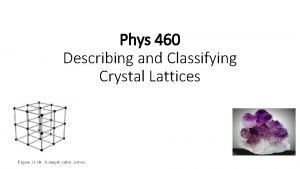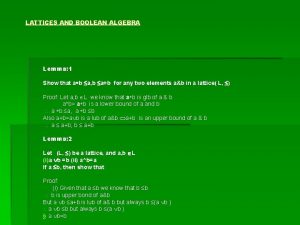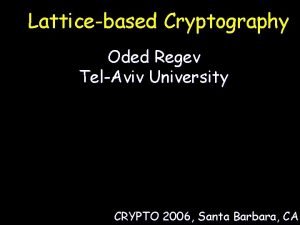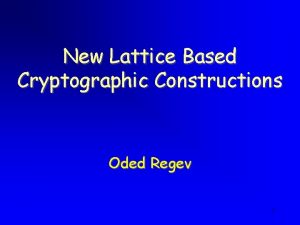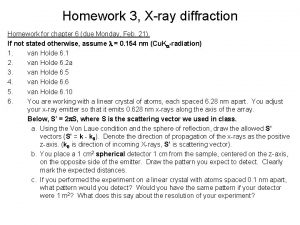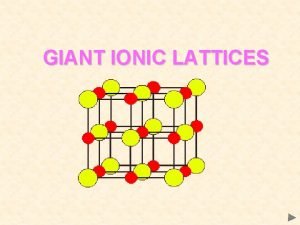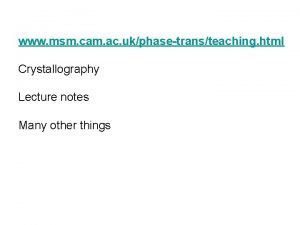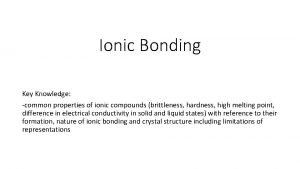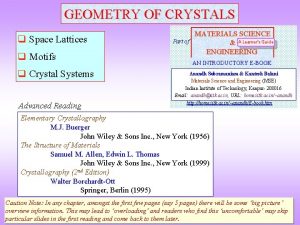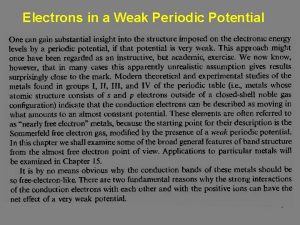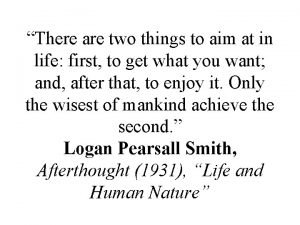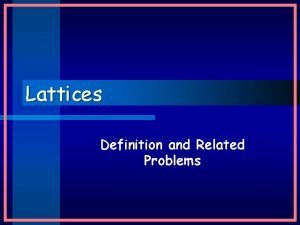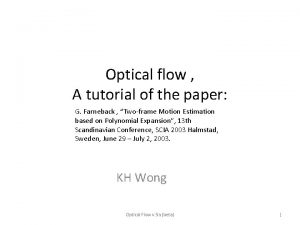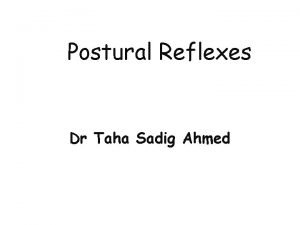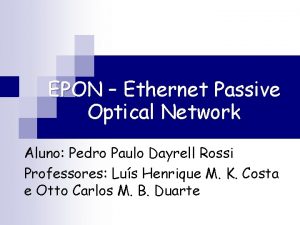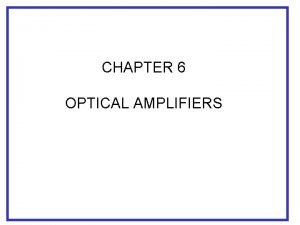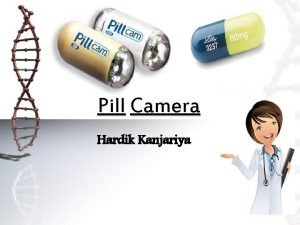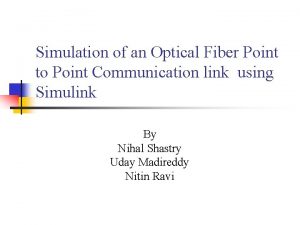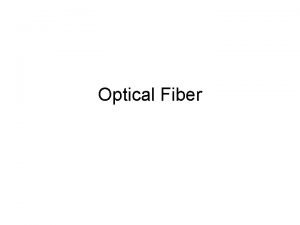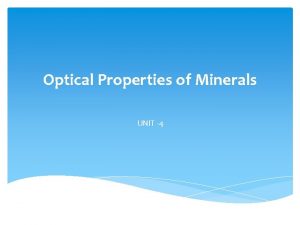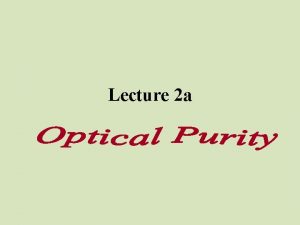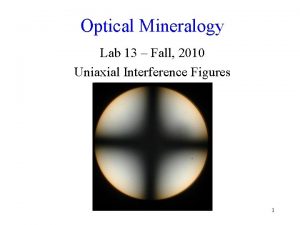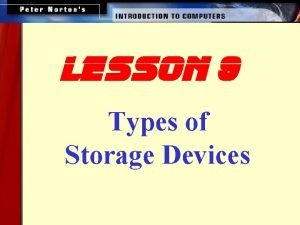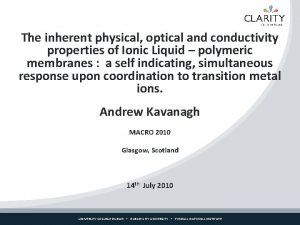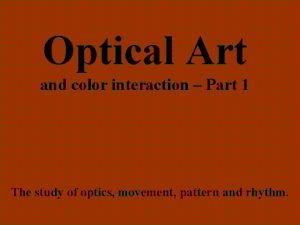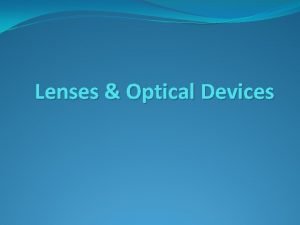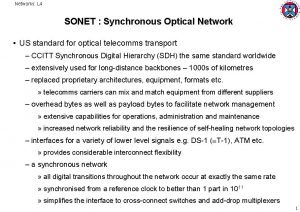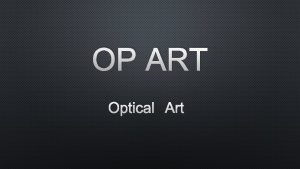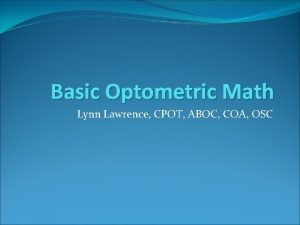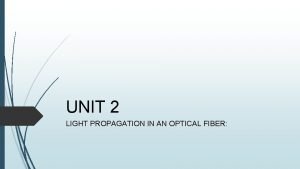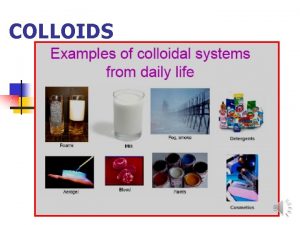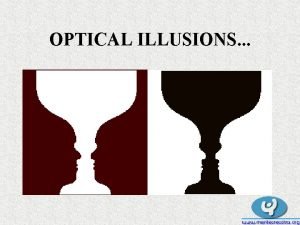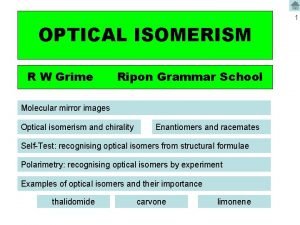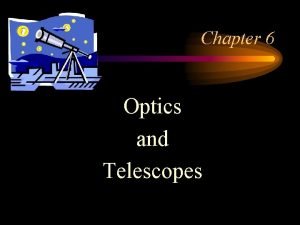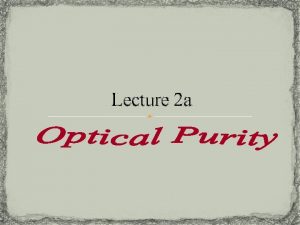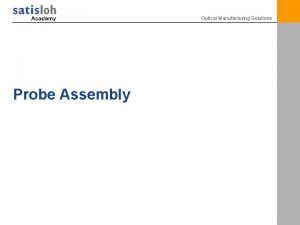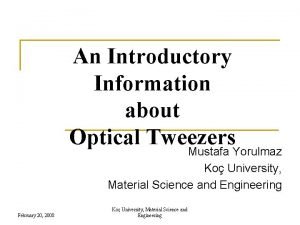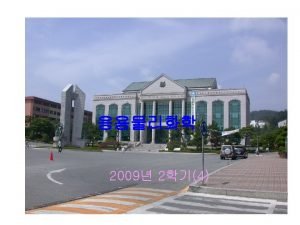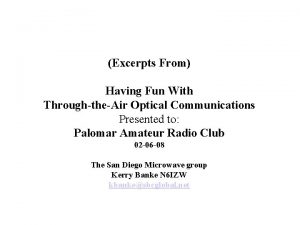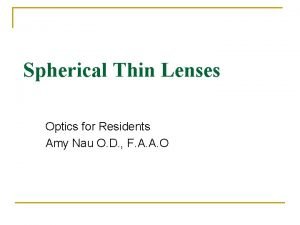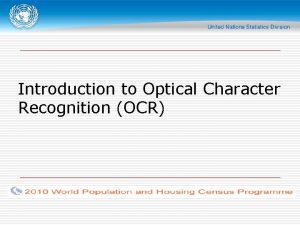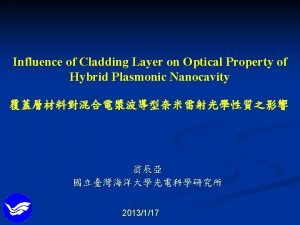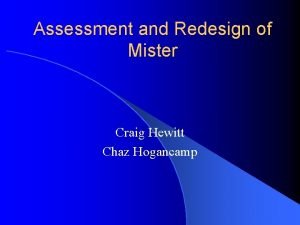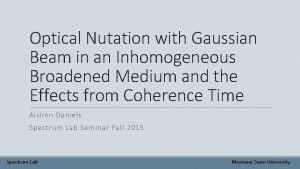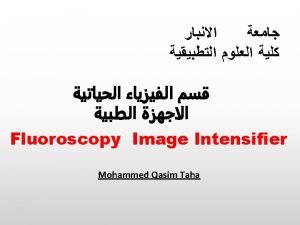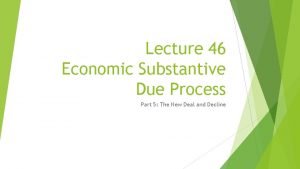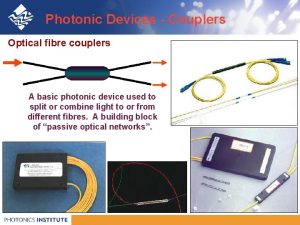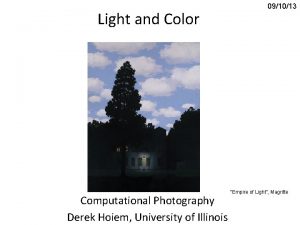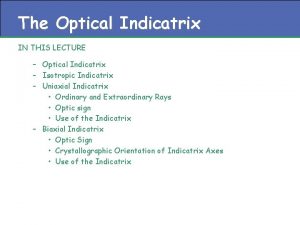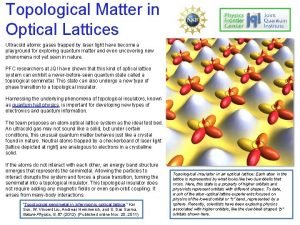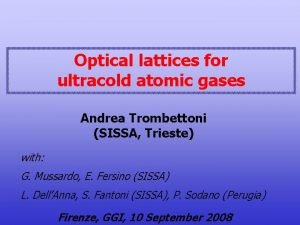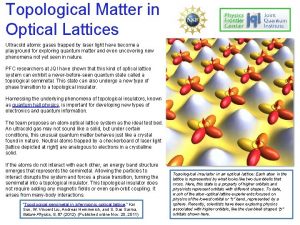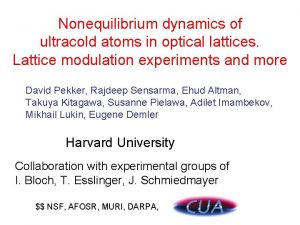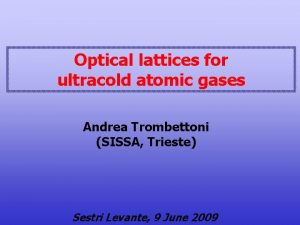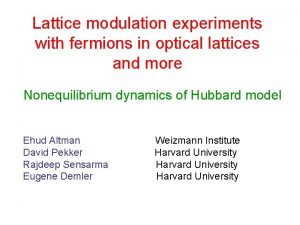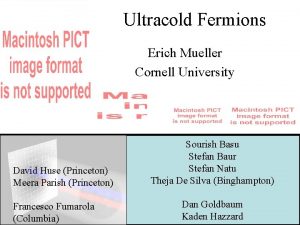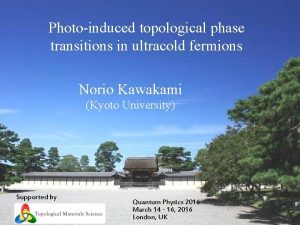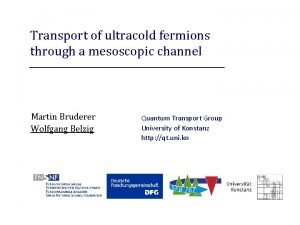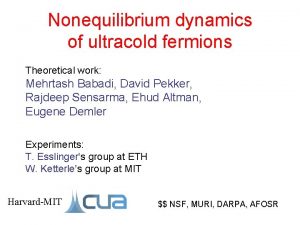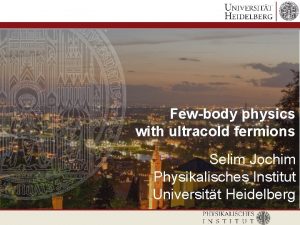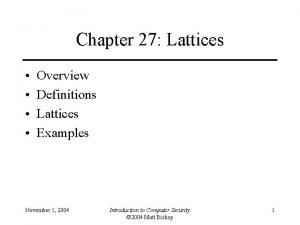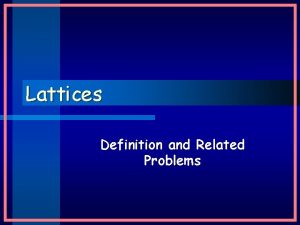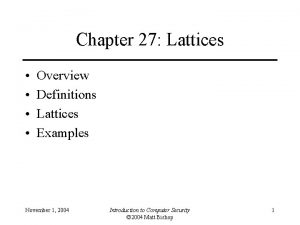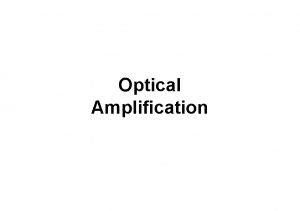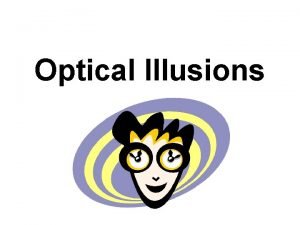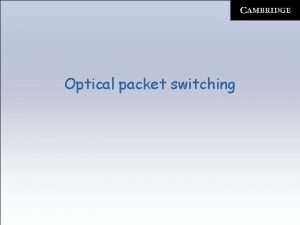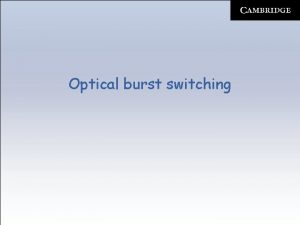Lecture 2 Ultracold fermions Fermions in optical lattices

































































- Slides: 65

Lecture 2: Ultracold fermions Fermions in optical lattices. Fermi Hubbard model. Current state of experiments Lattice modulation experiments Doublon lifetimes Stoner instability

Ultracold fermions in optical lattices

Fermionic atoms in optical lattices U t t Experiments with fermions in optical lattice, Kohl et al. , PRL 2005

Quantum simulations with ultracold atoms Atoms in optical lattice Antiferromagnetic and superconducting Tc of the order of 100 K Antiferromagnetism and pairing at sub-micro Kelvin temperatures Same microscopic model

Positive U Hubbard model Possible phase diagram. Scalapino, Phys. Rep. 250: 329 (1995) Antiferromagnetic insulator ? D-wave superconductor -

Repulsive Hubbard model at half-filling TN current experiments Mott state without AF order U

Signatures of incompressible Mott state of fermions in optical lattice Suppression of double occupancies R. Joerdens et al. , Nature (2008) Compressibility measurements U. Schneider et al. , Science (2008)

Lattice modulation experiments with fermions in optical lattice. Probing the Mott state of fermions Sensarma, Pekker, Lukin, Demler, PRL (2009) Related theory work: Kollath et al. , PRL (2006) Huber, Ruegg, PRB (2009) Orso, Iucci, et al. , PRA (2009)

Lattice modulation experiments Probing dynamics of the Hubbard model Modulate lattice potential Measure number of doubly occupied sites Main effect of shaking: modulation of tunneling Doubly occupied sites created when frequency w matches Hubbard U

Lattice modulation experiments Probing dynamics of the Hubbard model R. Joerdens et al. , Nature 455: 204 (2008)

Mott state Regime of strong interactions U>>t. Mott gap for the charge forms at Antiferromagnetic ordering at “High” temperature regime All spin configurations are equally likely. Can neglect spin dynamics. “Low” temperature regime Spins are antiferromagnetically ordered or have strong correlations

Schwinger bosons and Slave Fermions Bosons Fermions Constraint : Singlet Creation Boson Hopping

Schwinger bosons and slave fermions Fermion hopping Propagation of holes and doublons is coupled to spin excitations. Neglect spontaneous doublon production and relaxation. Doublon production due to lattice modulation perturbation Second order perturbation theory. Number of doublons

“Low” Temperature Schwinger bosons Bose condensed d Propagation of holes and doublons strongly affected by interaction with spin waves h Assume independent propagation of hole and doublon (neglect vertex corrections) Self-consistent Born approximation Schmitt-Rink et al (1988), Kane et al. (1989) = + Spectral function for hole or doublon Sharp coherent part: dispersion set by t 2/U, weight by t/U Incoherent part: dispersion Oscillations reflect shake-off processes of spin waves

“Low” Temperature Rate of doublon production • Sharp absorption edge due to coherent quasiparticles • Broad continuum due to incoherent part • Spin wave shake-off peaks

“High” Temperature Calculate self-energy of doublons and holes interacting with incoherent spin excitations (Schwinger bosons) in the non-crossing approximation Sensarma et al. , PRL (2009) Tokuno et al. ar. XIv: 1106. 1333 Equivalent to Retraceable Path Approximation Brinkmann & Rice, 1970 In calculating spectral function consider paths with no closed loops

“High” Temperature Spectral Fn. of single hole Doublon production rate d h Experiment: R. Joerdens et al. , Nature 455: 204 (2008) Theory: Sensarma et al. , PRL (2009) Tokuno et al. ar. XIv: 1106. 1333

Temperature dependence Psinglet Density Reduced probability to find a singlet on neighboring sites Radius D. Pekker et al. , upublished

Fermions in optical lattice. Decay of repulsively bound pairs Experiments: ETH group Theory: Sensarma, Pekker, et. al. Ref: N. Strohmaier et al. , PRL 2010

Fermions in optical lattice. Decay of repulsively bound pairs Doublons – repulsively bound pairs What is their lifetime? Direct decay is not allowed by energy conservation Excess energy U should be converted to kinetic energy of single atoms Decay of doublon into a pair of quasiparticles requires creation of many particle-hole pairs

Fermions in optical lattice. Decay of repulsively bound pairs Experiments: N. Strohmaier et. al.

Relaxation of doublon- hole pairs in the Mott state Energy U needs to be absorbed by spin excitations v. Energy carried by spin excitations ~J =4 t 2/U Relaxation rate v Relaxation requires creation of ~U 2/t 2 spin excitations Sensarma et al. , PRL 2011 Very slow, not relevant for ETH experiments

Doublon decay in a compressible state Excess energy U is converted to kinetic energy of single atoms Compressible state: Fermi liquid description p -h Doublon can decay into a pair of quasiparticles with many particle-hole pairs U p -h p -p

Doublon decay in a compressible state Perturbation theory to order n=U/6 t Decay probability Doublon Propagator Interacting “Single” Particles

Doublon decay in a compressible state N. Strohmaier et al. , PRL 2010 Expt: ETHZ Theory: Harvard To calculate the rate: consider processes which maximize the number of particle-hole excitations

Why understanding doublon decay rate is interesting Important for adiabatic preparation of strongly correlated systems in optical lattices Response functions of strongly correlated systems at high frequencies. Important for numerical analysis. Prototype of decay processes with emission of many interacting particles. Example: resonance in nuclear physics: (i. e. delta-isobar) Analogy to pump and probe experiments in condensed matter systems

Doublon relaxation in organic Mott insulators ET-F 2 TCNQ

One dimensional Mott insulator ET-F 2 TCNQ t=0. 1 e. V U=0. 7 e. V

Photoinduced metallic state H. Okamoto et al. , PRL 98: 37401 (2007) S. Wall et al. Nature Physics 7: 114 (2011) Surprisingly long relaxation time 840 fs h/t = 40 fs

Photoinduced metallic state H. Okamoto et al. , PRL 98: 37401 (2007) S. Wall et al. Nature Physics 7: 114 (2011) t=0. 1 e. V w=4 t=0. 4 e. V U=0. 7 e. V 1400 fs comparable to experimentally measured 840 ms

Exploring beyond simple Hubbard model with ultracold fermions

SU(N) Hubbard model with Ultracold Alkaline-Earth Atoms Theory: A. Gorshkov, et al. , Nature Physics 2010 Ex: 87 Sr (I = 9/2) |e> = 3 P 0 698 nm 150 s ~ 1 m. Hz |g> = 1 S 0 Experiments: realization of SU(6) fermions Takahashi et al. PRL (2010) Also J. Ye et al. , Science (2011) Nuclear spin decoupled from electrons SU(N=2 I+1) symmetry → SU(N) Hubbard models ⇒ valence-bond-solid & spin-liquid phases • orbital degree of freedom ⇒ spin-orbital physics → Kugel-Khomskii model [transition metal oxides with perovskite structure] → SU(N) Kondo lattice model [for N=2, colossal magnetoresistance in manganese oxides and heavy fermion materials]

Nonequilibrium dynamics: expansion of interacting fermions in optical lattice U. Schneider et al. , Nature Physics 2012 New dynamical symmetry: identical slowdown of expansion for attractive and repulsive interactions

Competition between pairing and ferromagnetic instabilities in ultracold Fermi gases near Feshbach resonances Phys. Rev. Lett. 2010 D. Pekker, M. Babadi, R. Sensarma, N. Zinner, L. Pollet, M. Zwierlein, E. Demler Motivated by experiments of G. -B. Jo et al. , Science (2009)

Stoner model of ferromagnetism Spontaneous spin polarization decreases interaction energy but increases kinetic energy of electrons Mean-field criterion U N(0) = 1 U – interaction strength N(0) – density of states at Fermi level Kanamori’s counter-argument: renormalization of U. then Theoretical proposals for observing Stoner instability with cold gases: Salasnich et. al. (2000); Sogo, Yabu (2002); Duine, Mac. Donald (2005); Conduit, Simons (2009); Le. Blanck et al. (2009); … Recent work on hard sphere potentials: Pilati et al. (2010); Chang et al. (2010)

Earlier work by C. Salomon et al. , 2003 Experiments were done dynamically. What are implications of dynamics? Why spin domains could not be observed?

Is it sufficient to consider effective model with repulsive interactions when analyzing experiments? Feshbach physics beyond effective repulsive interaction

Feshbach resonance Interactions between atoms are intrinsically attractive Effective repulsion appears due to low energy bound states Example: V(x) V 0 tunable by the magnetic field Can tune through bound state scattering length

Feshbach resonance Two particle bound state formed in vacuum Stoner instability BCS instability Molecule formation and condensation This talk: Prepare Fermi state of weakly interacting atoms. Quench to the BEC side of Feshbach resonance. System unstable to both molecule formation and Stoner ferromagnetism. Which instability dominates ?

Pair formation

Two-particle scattering in vacuum p k -k -p Microscopic Hamiltonian Schrödinger equation

T-matrix Lippman-Schwinger equation k k -k p -p k p -k -p k p’ -p’ p -p On-shell T-matrix. Universal low energy expression For positive scattering length bound state at appears as a pole in the T-matrix

Cooperon Two particle scattering in the presence of a Fermi sea Need to make sure that we do not include interaction effects on the Fermi liquid state in scattered state energy p k -k -p

Cooperon vs T-matrix k k -k p -p k p -k -p k p’ -p’ p -p

Cooper channel response function Linear response theory Induced pairing field Response function Poles of the Cooper channel response function are given by

Cooper channel response function Linear response theory Poles of the response function, describe collective modes , Time dependent dynamics When the mode frequency has negative imaginary part, the system is unstable

Pairing instability regularized BCS side Instability rate coincides with the equilibrium gap (Abrikosov, Gorkov, Dzyaloshinski) Instability to pairing even on the BEC side Related work: Lamacraft, Marchetti, 2008

Pairing instability Intuition: two body collisions do not lead to molecule formation on the BEC side of Feshbach resonance. Energy and momentum conservation laws can not be satisfied. This argument applies in vacuum. Fermi sea prevents formation of real Feshbach molecules by Pauli blocking. Molecule Fermi sea

Pairing instability Time dependent variational wavefunction Time dependence of uk(t) and vk(t) due to DBCS(t) For small DBCS(t):

Pairing instability Effects of finite temperature Three body recombination as in Shlyapnikov et al. , 1996; Petrov, 2003; Esry 2005 From wide to narrow resonances Observed in recent experiments by Grimm’s group, ar. Xiv: 1112. 0020

Magnetic instability

Stoner instability. Naïve theory Linear response theory Spin response function Spin collective modes are given by the poles of response function Negative imaginary frequencies correspond to magnetic instability

RPA analysis for Stoner instability Self-consistent equation on response function Spin susceptibility for non-interacting gas RPA expression for the spin response function

Quench dynamics across Stoner instability Stoner criterion For U>Uc unstable collective modes Unstable modes determine characteristic lengthscale of magnetic domains

Stoner quench dynamics in D=3 Scaling near transition Growth rate of magnetic domains Domain size Unphysical divergence of the instability rate at unitarity

Stoner instability = + + Stoner instability is determined by two particle scattering amplitude Divergence in the scattering amplitude arises from bound state formation. Bound state is strongly affected by the Fermi sea. + …

Stoner instability RPA spin susceptibility Interaction = Cooperon

Stoner instability Pairing instability always dominates over pairing If ferromagnetic domains form, they form at large q

Tests of the Stoner magnetism C. Sanner et al. , ar. Xiv: 1108. 2017 Spin fluctuations relative to noninteracting fermions Extremely fast molecule formation rate at short times Only short range correlations and no domain formation Atoms loss rate is 13% of EF on resonance (averaged over trap)

Lecture 2: Ultracold fermions Fermions in optical lattices. Fermi Hubbard model. Current state of experiments Lattice modulation experiments Doublon lifetimes Stoner instability

Future directions in ultracold atoms Nonequilibrium quantum many-body dynamics Long intrinsic time scales - Interaction energy and bandwidth ~ 1 k. Hz - System parameters can be changed over this time scale Decoupling from external environment - Long coherence times Can achieve highly non equilibrium quantum many-body states

Emergent phenomena in dynamics of classical systems Universality in quantum manybody systems in equilibrium Solitons in nonlinear wave propagation Broken symmetries Bernard cells in the presence of T gradient Fermi liquid state Do we have emergent universal phenomena in nonequilibrium dynamics of many-body quantum systems?


Hubbard model at half filling TN Paramagnetic Mott phase: paramagnetic Mott phase one fermion per site charge fluctuations suppressed no spin order U BCS-type theory applies Heisenberg model applies

Hubbard model at half filling TN current experiments U BCS-type theory applies Heisenberg model applies
 Fermions obeys
Fermions obeys Fiducary
Fiducary Pauli blocking of light scattering in degenerate fermions
Pauli blocking of light scattering in degenerate fermions Optical amplifiers lecture notes
Optical amplifiers lecture notes Glide reflection
Glide reflection 14 bravais lattices
14 bravais lattices Bravais lattice
Bravais lattice State and prove isotonicity property in a lattice
State and prove isotonicity property in a lattice Oded regev lattices
Oded regev lattices Oded regev lattices
Oded regev lattices Homework
Homework Giant ionic compounds
Giant ionic compounds Bravais lattices
Bravais lattices Common properties of ionic compounds
Common properties of ionic compounds 7 crystal systems and 14 bravais lattices
7 crystal systems and 14 bravais lattices Electrons in periodic lattices
Electrons in periodic lattices 7 crystal systems and 14 bravais lattices
7 crystal systems and 14 bravais lattices Lattices definition
Lattices definition 01:640:244 lecture notes - lecture 15: plat, idah, farad
01:640:244 lecture notes - lecture 15: plat, idah, farad Optical flow tutorial
Optical flow tutorial Postural reflexes
Postural reflexes Literary device scanner
Literary device scanner Software
Software Gigabit ethernet passive optical network
Gigabit ethernet passive optical network Fibre optic advantages and disadvantages
Fibre optic advantages and disadvantages In-line optical dwdm amplifiers
In-line optical dwdm amplifiers Hardik kanjariya
Hardik kanjariya Optical fiber simulation
Optical fiber simulation Optical fibre cable definition
Optical fibre cable definition Perpendicular
Perpendicular How to calculate percent optical purity
How to calculate percent optical purity Precision optical instruments laboratory
Precision optical instruments laboratory Flash figure optical mineralogy
Flash figure optical mineralogy What are optical storage devices are most commonly known as
What are optical storage devices are most commonly known as Inherent optical properties
Inherent optical properties Color wheel optical illusion
Color wheel optical illusion Optical devices
Optical devices Qa optical surface
Qa optical surface Sonet synchronous optical network
Sonet synchronous optical network Op
Op Transpose glasses rx
Transpose glasses rx Numerical aperture formula
Numerical aperture formula Protective colloid
Protective colloid Optical illusions for kids
Optical illusions for kids Pxi optical switch
Pxi optical switch 2-chlorobutane optical isomers
2-chlorobutane optical isomers All modern large optical telescopes are refractors.
All modern large optical telescopes are refractors. Optical purity
Optical purity Optical manufacturing solutions
Optical manufacturing solutions Optical mesh network
Optical mesh network Optical tweezers
Optical tweezers Specific rotation
Specific rotation Optical networking technology
Optical networking technology Optical beacon
Optical beacon Infinite imaging
Infinite imaging Ocr full form
Ocr full form Optical cladding
Optical cladding Optical art scuola primaria
Optical art scuola primaria Hogancamp optical
Hogancamp optical Optical nutation
Optical nutation Real time fluoroscopy
Real time fluoroscopy Williamson v. lee optical
Williamson v. lee optical Bragg filtering
Bragg filtering Echalk optical illusions
Echalk optical illusions Optical isomers of octahedral complexes
Optical isomers of octahedral complexes Isotropic indicatrix
Isotropic indicatrix
